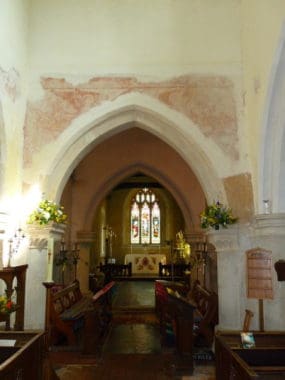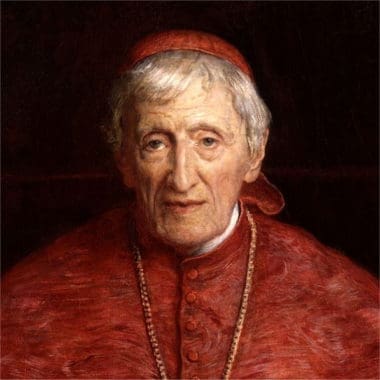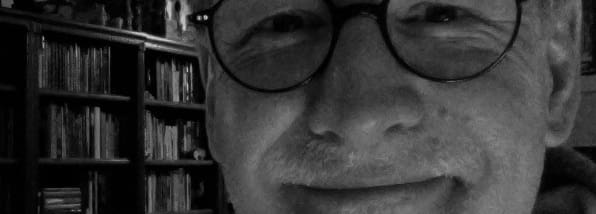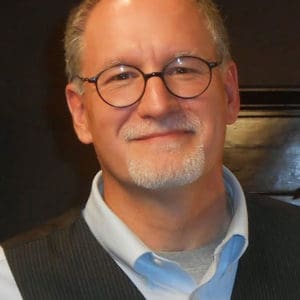Life as I See It
I have written elsewhere that the genius of Anglicanism was in its integration of aspects of Catholicism with Reformation thought. As a Protestant, this was appealing to me because of its familiarity. As someone who didn’t know much about Catholicism, I didn’t realize just how Catholic many of its practices were. The more I studied and became more engaged in Anglicanism, the more I believed it was the best of both possible worlds.
 I could not have known that Anglicanism was introducing me to Catholic concepts. One day we visited a church in a small village called Nether Wallop. It was built in 900 and someone had recently discovered a mural under the plaster of Jesus and the disciples at the Last Supper. I stood in amazement as I realized that many of the words I said every Sunday in church had been said in that building for the last 1100 years, my voice joining in a chorus with all those Christians who’d come before me. I became aware of being part of a very long and wondrous stream. The idea of a Communion of the Saints became real to me.
I could not have known that Anglicanism was introducing me to Catholic concepts. One day we visited a church in a small village called Nether Wallop. It was built in 900 and someone had recently discovered a mural under the plaster of Jesus and the disciples at the Last Supper. I stood in amazement as I realized that many of the words I said every Sunday in church had been said in that building for the last 1100 years, my voice joining in a chorus with all those Christians who’d come before me. I became aware of being part of a very long and wondrous stream. The idea of a Communion of the Saints became real to me.
Within a year, my work necessitated a move from England to Colorado. There we found an Episcopal Church that was, in many ways, more Anglican than anything we had experienced in England. It was soundly liturgical and deeply theological in all aspects of what it did. Nothing was taken for granted. Every aspect of the church was infused with meaning. I believed I had reached the end of my search for the church of Christ. I believed I could grow spiritually and engage in the disciplines of the “Ancient Church.” I had no idea what that really meant, but I was willing to find out.
I have often misquoted author Richard Foster as saying that most Protestants don’t know their church history very well. They think there was the First Century Church, a “blip” called the Reformation, and then Billy Graham. As an Anglican, I learned what had happened in the 500 years before Rev. Graham. I responded in all the right ways to the writings of Cranmer and Hooker and more contemporary writers like NT Wright.
I appreciated what it meant to pray prayers written by others, not only because they were beautifully worded and often articulated my heart better than I could, but because they got me out of the ruts of my own thinking, pushing me into new spiritual directions. I gained a whole new appreciation for beauty in worship. I explored spiritual disciplines like meditation and contemplation, never realizing they had come from the Catholic Church.
I also saw a loosening of my Baptist understanding of Sola Scriptura, as I came to understand the Bible’s interplay with Tradition and Reason. There was an undeniable dynamic between the three that had guided the church – at least for 500 years (I couldn’t address what happened before that).
I recognized the importance and necessity of Church hierarchy (not bureaucracy) as a Biblically-based reality, going back to the Book of Acts and the Ancient Church. I had only a vague notion of what Apostolic Succession was or meant, apart from being a remarkable lineage, like a royal family. The Anglican Bishops had authority but were not really authoritative.
Was I comfortable with everything Anglicans believed? No. There were tendencies in the national Episcopal church that struck me as anti-orthodox, where leadership dispensed with Scripture and Tradition a little too readily to accommodate so-called tolerance and a guilt-free form of repentance. Theological innovations seemed untethered, resembling secular sensibilities more and more. I was troubled, but not undone. It was easy to look the other way. Anglicanism allowed me to believe a lot of what I wanted to believe within the context of its structure. And our congregation was solidly orthodox, representing the best of Anglicanism, even when the national church didn’t. I thought we were safe as a congregation as long as we were left alone.
All of that changed as we entered the 21st century. With breath-taking speed, the theology and policies of the national Episcopal church changed and collided with Biblical and Traditional teaching. Our local assembly was no longer impervious to a “scorched earth” approach by national and diocesan leadership that would rather have an orthodox church dead than thriving with teachings it didn’t like.
My idealism about Anglicanism smashed against reality. I couldn’t imagine how Bishops could elect someone to the Bishopric whose lifestyle clearly contradicted Biblical and Traditional teaching. I heard other Bishops in interviews explain how the Apostle Paul and the writers of the New Testament simply didn’t understand these things as well as we do now. And I thought, Really? The writers of the New Testament were ignorant? The Son of God Himself didn’t understand?
So my relaxed notion of the church and Apostolic Succession was challenged by the alarming conclusions of the current Episcopalian Bishops. I didn’t know what to make of it all. I read a lucid article by a renowned Bishop arguing that the “500 year Anglican experiment” was over. I didn’t  believe it. My instinct was to fight the fight along with orthodox Anglicans everywhere. But I wondered what I was fighting for.
believe it. My instinct was to fight the fight along with orthodox Anglicans everywhere. But I wondered what I was fighting for.
From many conflicting and contradictory feelings, I came to one of the most important questions of my life: who has the authority to interpret Scripture and establish doctrine?
To answer that question I had to go back in time, beyond the 500-year threshold I had maintained in my 15 years as an Anglican. I went to the Ancient Church to find out what it believed and why. I wasn’t looking to become a Catholic. Yet, as John Henry Newman observed, “To be steeped in history is to cease being a Protestant.” And he was right.
Art: Nether Wallop – St Andrews Church Above this Norman arch is a much older wall painting that dates back to saxon [sic] times, photographed by Chris Talbot, 10 April 2010, CCA-SA 2.0 Generic; John Henry Newman, Sir John Everett Millais, date unknown (author died in 1896), PD-US author’s life plus 100 years or less, published in the U.S. prior to January 1, 1923; both Wikimedia Commons.





